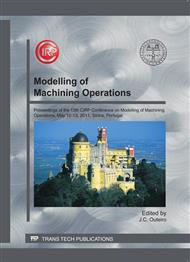[1]
J. Mackerle: Finite-element analysis and simulation of machining: a bibliography (1976–1996), J. Mater. Process. Tec., 86, (1999), 17–44.
DOI: 10.1016/s0924-0136(98)00227-1
Google Scholar
[2]
J. Mackerle: Finite element analysis and simulation of machining: an addendum: A bibliography (1996–2002), Int. J. Mach. Tools Manuf., 43, (2003), 103-114.
DOI: 10.1016/s0890-6955(02)00162-1
Google Scholar
[3]
A. E. Tekkaya and P. A. F. Martins: Accuracy, reliability and validity of finite element analysis in metal forming: a user's perspective, Eng. Comput., 26, (2009), 1026-1055.
DOI: 10.1108/02644400910996880
Google Scholar
[4]
C. M. Silva, P. A. R. Rosa and P. A. F. Martins: An innovative electromagnetic compressive split Hopkinson bar, Int. J. Mech. Mater. Des., 5, (2009), 281-288.
DOI: 10.1007/s10999-009-9101-y
Google Scholar
[5]
W. Grzesik, Z. Zalisz, P. Nieslony: Friction and wear testing of multilayer coatings on carbide substrates for dry machining applications, Surf. Coat. Tech., 155, (2002), 37–45.
DOI: 10.1016/s0257-8972(02)00040-3
Google Scholar
[6]
V. A. M. Cristino, P. A. R. Rosa and P. A. F. Martins: On the utilization of pin-on-disc simulative tests for the calibration of friction in metal cutting, J. Eng. Tribol., 224, (2010), 169-177.
DOI: 10.1243/13506501jet639
Google Scholar
[7]
V. P. Astakhov: Tribology of metal cutting, Elsevier, (2006), Oxford.
Google Scholar
[8]
V. A. M. Cristino, P. A. R. Rosa and P. A. F. Martins: Cutting under active and inert gas shields: a contribution to the mechanics of chip flow, Int. J. Mach. Tools Manuf., 50, (2010), 892-900.
DOI: 10.1016/j.ijmachtools.2010.06.003
Google Scholar
[9]
N. Zorev: Metal cutting mechanics, Pergamon Press, (1966), Oxford.
Google Scholar
[10]
M. C. Shaw: Metal cutting principles, Clarendon Press, (1984), Oxford.
Google Scholar
[11]
P. L. Oxley: Mechanics of machining: An analytical approach to assessing machinability, John Wiley & Sons, (1989), New York.
Google Scholar
[12]
A. G. Atkins: Modelling metal cutting using modern ductile fracture mechanics: quantitative explanations for some longstanding problems, Int. J. Mech. Sci., 45, (2003), 373-396.
DOI: 10.1016/s0020-7403(03)00040-7
Google Scholar
[13]
P. A. R. Rosa, P. A. F. Martins and A. G. Atkins: Revisiting the fundamentals of metal cutting by means of finite elements and ductile fracture mechanics, Int. J. Mach. Tools Manuf., 47, (2007), 607–617.
DOI: 10.1016/j.ijmachtools.2006.05.003
Google Scholar
[14]
P. A. R. Rosa, O. Kolednik, P. A. F. Martins and A. G. Atkins: The transient beginning to machining and the transition to steady-state cutting, Int. J. Mach. Tools Manuf., 47, (2007), 1904–1915.
DOI: 10.1016/j.ijmachtools.2007.03.005
Google Scholar
[15]
M. L. Alves, J. M. C. Rodrigues and P. A. F. Martins: Simulation of three-dimensional bulk forming processes by the finite element flow formulation, Model. Simul. Mater. Sci. Eng. – Inst. Phys., 11, (2003), 803-821
DOI: 10.1088/0965-0393/11/5/307
Google Scholar


